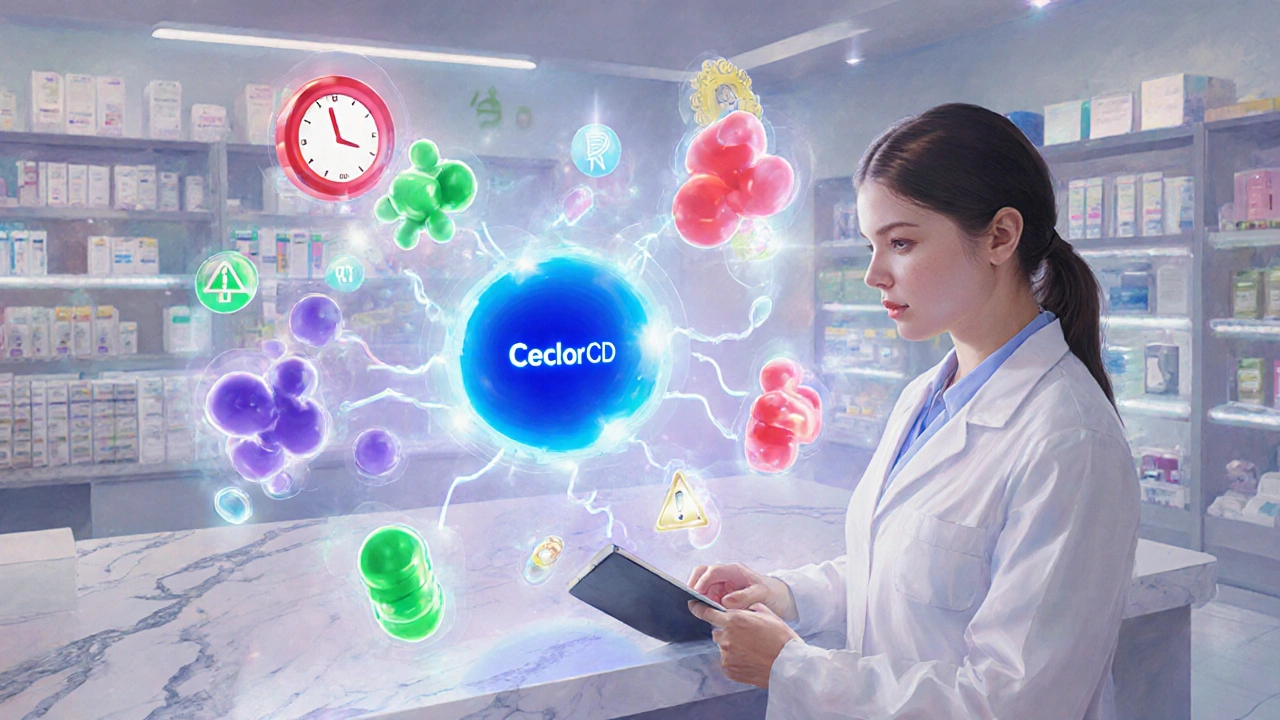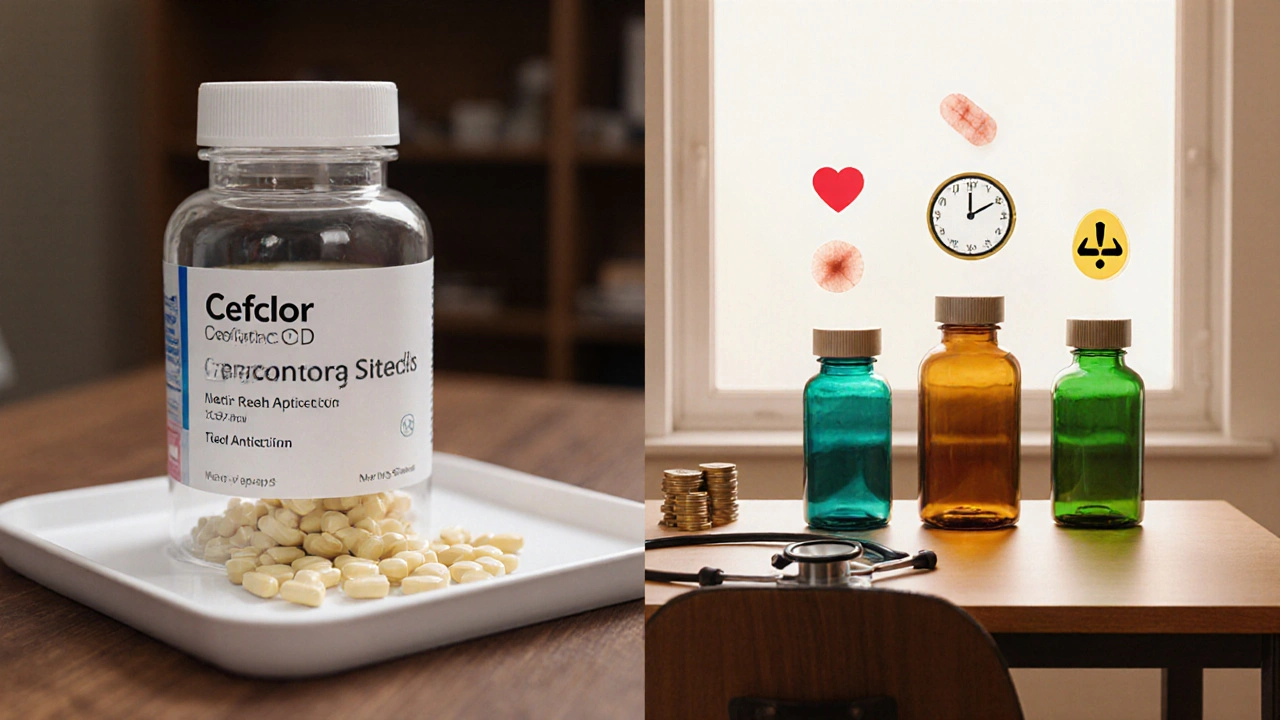Antibiotic Choice Decision Tree
Recommended Antibiotic:
Quick Take
- Ceclor CD is a second‑generation cephalosporin used for ear, sinus, throat and skin infections.
- It shares a beta‑lactam ring with penicillins but resists some bacterial enzymes.
- Common alternatives include amoxicillin, azithromycin, cephalexin, doxycycline and amoxicillin‑clavulanate.
- Choose based on infection type, resistance patterns, patient age and allergy history.
- Cost and dosing frequency often tip the balance in real‑world prescribing.
When the doctor writes Ceclor CD, you’re probably looking at a bottle of 250mg or 500mg tablets meant to chase down a bacterial infection that hasn’t responded to first‑line penicillins. But the market is crowded with other antibiotics that promise the same outcome with different trade‑offs. Below we break down what makes Ceclor CD tick, compare it side‑by‑side with the most common substitutes, and give you a decision‑tree you can actually use at the pharmacy counter.
What Is Ceclor CD (Cefaclor)?
Cefaclor is a second‑generation oral cephalosporin antibiotic, sold in the UK under the brand name Ceclor CD. It works by inhibiting bacterial cell‑wall synthesis, a mechanism it shares with penicillins but with a broader spectrum against Gram‑negative organisms like Haemophilus influenzae. Typically prescribed for acute otitis media, sinusitis, pharyngitis, bronchitis and uncomplicated skin infections, the standard adult dose is 250-500mg every 6-8hours for 7-10days.
Side effects are usually mild-GI upset, rash, or a transient increase in liver enzymes-but rare cases of severe allergic reactions (anaphylaxis) have been reported, especially in patients with a known penicillin allergy.
How Ceclor CD Works: The Science in Plain English
Ceclor CD belongs to the beta‑lactam family. The beta‑lactam ring binds to penicillin‑binding proteins (PBPs) inside the bacterial cell wall, halting the cross‑linking of peptidoglycan strands. Without a sturdy wall, the bacterium swells and bursts. Compared with first‑generation cephalosporins, cefaclor’s side chain grants better penetration of the outer membrane of certain Gram‑negative bugs, making it a go‑to when amoxicillin fails.
However, the same beta‑lactam core also means that cross‑reactivity with penicillin allergies hovers around 5‑10%. If you’ve ever reacted to amoxicillin, discuss skin‑testing with your clinician before starting Ceclor CD.
Top Alternatives: Who They Are and What They Do
Below are the most frequently swapped antibiotics when clinicians consider a switch from cefaclor.
- Amoxicillin is a broad‑spectrum penicillin that targets many of the same Gram‑positive organisms as cefaclor but is less effective against H. influenzae. Typical dose: 500mg three times daily.
- Azithromycin is a macrolide that binds the 50S ribosomal subunit, halting protein synthesis. It’s favored for atypical pathogens and has a convenient three‑day regimen (500mg daily).
- Cephalexin is a first‑generation cephalosporin, excellent for skin and soft‑tissue infections but weaker against Gram‑negative respiratory bugs. Dose: 250‑500mg four times daily.
- Doxycycline is a tetracycline that blocks bacterial protein synthesis. It’s a solid choice for community‑acquired pneumonia and tick‑borne illnesses, with a 100mg twice‑daily schedule.
- Amoxicillin‑Clavulanate pairs amoxicillin with a β‑lactamase inhibitor, widening coverage against resistant strains like Streptococcus pneumoniae. Dose ranges from 500/125mg three times daily to 875/125mg twice daily.

Side‑by‑Side Comparison Table
| Antibiotic | Class | Typical Indications | Common Dose (adult) | Gram‑negative Coverage | Allergy Cross‑reactivity | Cost (UK, avg.) |
|---|---|---|---|---|---|---|
| Ceclor CD (Cefaclor) | Second‑gen cephalosporin | Otitis media, sinusitis, bronchitis, skin infection | 250‑500mg q6‑8h | Good (e.g., H. influenzae) | 5‑10% with penicillin | £6‑£9 per 10‑day course |
| Amoxicillin | Penicillin | Strep throat, pneumonia, otitis media | 500mg t.i.d. | Limited | High (direct allergy) | £4‑£6 per 10‑day course |
| Azithromycin | Macrolide | Atypical pneumonia, chlamydia, sinusitis | 500mg d1, then 250mg d2‑5 | Moderate | Low | £12‑£15 per 5‑day pack |
| Cephalexin | First‑gen cephalosporin | Skin, bone, urinary tract | 250‑500mg q6h | Poor | 5‑10% with penicillin | £5‑£8 per 7‑day course |
| Doxycycline | Tetracycline | Community‑acquired pneumonia, Lyme disease | 100mg b.i.d. | Broad | Low (except for rare hypersensitivity) | £7‑£10 per 10‑day pack |
| Amoxicillin‑Clavulanate | Penicillin + β‑lactamase inhibitor | Resistant sinusitis, ear infections | 500/125mg t.i.d. or 875/125mg b.i.d. | Very good | High (penicillin component) | £9‑£13 per 7‑day course |
When to Pick Ceclor CD Over the Rest
- Middle‑ear and sinus infections where H. influenzae is suspected: Ceclor’s extra Gram‑negative punch beats amoxicillin.
- Patients who need a short, three‑times‑daily regimen: Unlike azithromycin’s single‑dose regimen, Ceclor offers a balance between convenience and reliable blood levels.
- No known penicillin allergy: If the allergy history is unclear, a skin test is worth the extra visit before committing to Ceclor.
- Cost‑sensitive scenarios: Ceclor is generally cheaper than macrolides and combination drugs.
If any of these conditions don’t line up, you might lean to an alternative:
- Penicillin‑allergic patients: Azithromycin or doxycycline are safer bets.
- Severe or resistant infections: Amoxicillin‑clavulanate or a fluoroquinolone (e.g., levofloxacin) may be required.
- Skin and soft‑tissue abscesses: Cephalexin or doxycycline often give similar outcomes with less dosing frequency.
Practical Considerations: Resistance, Pediatric Use, and Real‑World Tips
Resistance is the silent enemy. In the UK, surveillance data from 2024 show a 12% resistance rate of H. influenzae to amoxicillin, but only 3% to cefaclor. That gap makes Ceclor CD a sensible second‑line choice when first‑line penicillins fail.
For kids, the pediatric dose is weight‑based: 25‑50mg/kg/day divided every 6-8hours. The oral suspension (125mg/5ml) is palatable and comes in a child‑proof bottle-perfect for parents who dread the bitter taste of many syrups.
Don’t overlook drug-food interactions. Dairy products can bind cefaclor and reduce absorption slightly; spacing the dose 2hours after calcium‑rich meals maximizes exposure.
Finally, remember to complete the full course-even if symptoms fade after 3days. Stopping early fuels resistant strains and may lead to a relapse that’s harder to treat.
Bottom Line Checklist
- Identify infection type and likely pathogen.
- Check allergy history (especially penicillin).
- Consider local resistance patterns-cefaclor retains strong activity against many respiratory Gram‑negatives.
- Match dosing convenience to patient lifestyle (3‑times‑daily vs. once‑daily).
- Factor cost and formulary availability.
Follow this flow, and you’ll land on the right antibiotic without second‑guessing the prescription.
Frequently Asked Questions
Can I take Ceclor CD if I’m allergic to amoxicillin?
Cross‑reactivity is about 5‑10%, so while many patients tolerate it, you should get an allergy test or discuss alternatives with your clinician before starting.
How long does a typical Ceclor CD course last?
Most acute infections are treated for 7-10days, but the exact duration depends on severity, site of infection, and patient response.
Is Ceclor CD safe during pregnancy?
It’s classified as Category B in the UK, meaning animal studies show no risk and there are no adequate human studies. Doctors usually prescribe it only if benefits outweigh potential risks.
Can I take Ceclor CD with antacids?
Antacids containing aluminum or magnesium can reduce cefaclor absorption. Space them at least two hours apart for optimal effectiveness.
What should I do if I miss a dose?
Take the missed tablet as soon as you remember, unless it’s almost time for the next dose. In that case, skip the missed one-don’t double‑dose.

